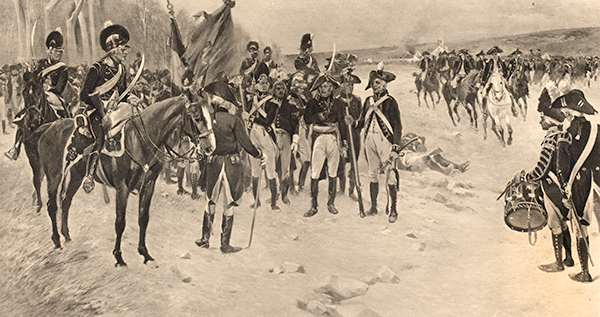RAISING THE IRISH MILITIA
Published in Issue 2 (March/April 2022), Volume 30By Fiona Fitzsimons
After 1695, the Penal Laws barred Catholics from bearing arms and from enlisting in the armed services, including the militia. In 1715 the militia was placed on a statutory basis, formalising arrangements set in place during the Williamite Wars. It was a part-time voluntary force, organised by county and paid for by the county cess. By the 1760s, institutional inertia had caused the militia to flounder. It left a gap into which the Volunteers inserted themselves after 1778. The success of the Volunteer movement underscored Ireland’s potential as a recruiting ground.
Britain’s wider imperial concerns forced the government to rethink its exclusion of Catholics from the military. In April 1793, the Catholic Relief Act gave Catholics the right to vote and removed most barriers to their enlistment and advancement in the military. In the same month, a new Militia Act laid the foundations for raising a modern militia.
The 1793 Militia Act required every civil parish to draw up lists of men aged 18–45, and to hold a ballot to choose those who would serve in the militia. If these records had survived, they would provide an annual male census for the district, with identifying details about the men and their family circumstances. Unfortunately, what evidence survives is scant and scattered between collections. It’s difficult to know where to search, not least because we know so little about how the ballot was taken. In May 1793,
‘… a meeting of the Governors and Deputy Governors of the city of Limerick was … held in the Exchange, for the purpose of receiving the returns from the High Constables and Church Wardens, of such men as the law directs to be balloted for the militia’.
Civil parishes were an arm of the government, and the Limerick City Exchange housed the council chamber. Ergo, we can deduce that enrolment records may have been local government records. This broadly corresponds with England and Wales, where what enrolment lists survive are in parish vestry records and local government collections. In June 1793, however, men from the county parishes physically assembled in Carlow town to attend the ballot held in the courthouse. Moreover, the several city parishes in Dublin scheduled their own ballots at the parish church in the week of 12–18 June 1793.
That balloting took place at different venues suggests more than one institution/government department at work in Ireland. This may explain why militia records in Ireland were never centralised, as in England and Wales. It may very well be that more material survives in the UK National Archives. A search of the catalogue showed ‘Militia regiments [of] Great Britain and Ireland’ (WO 68). These volumes include some enrolment and description books of the men chosen to serve, as well as records of casualties, desertions, courts martial and some original correspondence. The enrolment books are especially relevant to family historians tracing ancestors in the armed services: the books record each man’s name, age, description, height, place of birth, trade, former service (if any), enlisted (by whom, where and when), casualties (dead, discharged, deserted) and ‘further observations’.
Fiona Fitzsimons is a director of Eneclann, a Trinity campus company, and of findmypast Ireland.

















